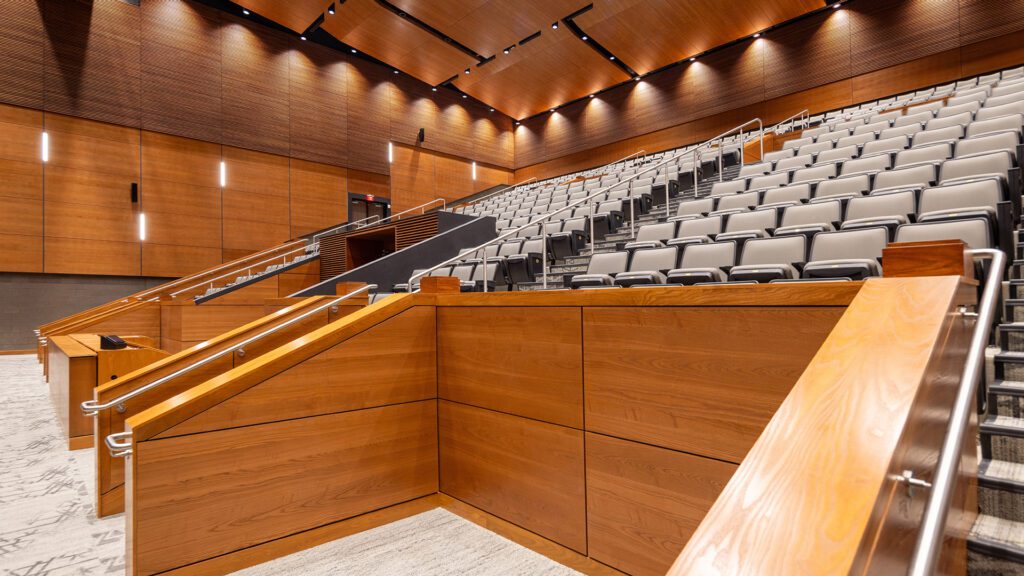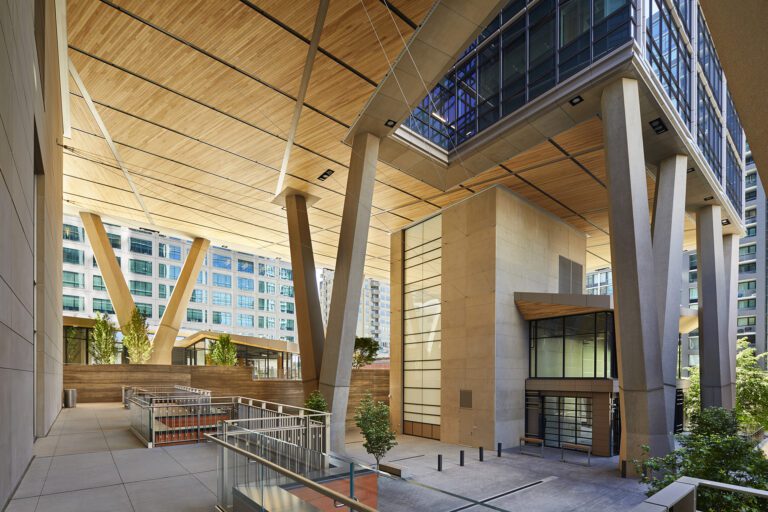Why Is Architectural Wood Paneling Gaining Popularity in Interior Design?
Interior designers are redefining the role of material selection—not just for aesthetics, but for impact on user experience, acoustics, and wellness. Among the most prominent trends in commercial spaces is the use of architectural wood paneling. No longer relegated to rustic or traditional settings, wood is now a modern design essential, offering a timeless palette with tactile richness and sustainable credibility.
Designers are responding to a growing demand for natural finishes that support both functionality and environmental goals. Architectural wood paneling brings warmth and texture to interiors while aligning with health-conscious and eco-aware building standards. Rulon’s commitment to low-VOC finishes, FSC-certified sourcing, and lifecycle transparency supports these objectives, as detailed on their Sustainability page.
Beyond sustainability, wood paneling creates an emotional connection within a space. Whether it’s a serene healthcare environment or a dynamic office lobby, natural wood surfaces influence how occupants feel, interact, and navigate their surroundings. Its material authenticity resonates with users, making it a powerful design tool for spaces intended to evoke comfort, creativity, or focus.
How Does Wood Paneling Influence Mood and Emotional Impact in Interiors?
Interior designers are increasingly drawn to the psychological and sensory effects of materials. Architectural wood paneling is uniquely positioned to influence mood through visual tone, tactile texture, and natural variation. These elements combine to produce an inviting, calming backdrop that enhances user well-being—particularly in commercial environments where first impressions and sustained comfort matter.
The use of Flat Veneer Panels enables designers to create refined surfaces that celebrate wood’s natural grain without overwhelming a space. Subtle patterning and a clean finish provide sophistication in boardrooms, lounges, or academic environments. Designers can also control reflectivity and contrast through finish options to suit the space’s desired ambiance.
Moreover, wood paneling introduces biophilic texture into spaces where users often seek sensory refuge. The familiarity of wood as a material—its warmth, softness, and natural imperfections—contributes to feelings of ease and trust. In high-pressure settings like healthcare waiting rooms or legal offices, this emotional effect can greatly enhance the environment’s usability and perception.
Case Study: Aesthetic and Acoustic Synergy in Higher Education
.A standout example of wood paneling’s dual benefits is the Maureen A. Daly Innovation and Collaboration Building at University of Tampa, where Rulon’s Aluratone acoustic wood panels were installed throughout shared learning areas to enhance both performance and ambiance.
Designers and architects collaborated to select materials that balanced acoustic performance with aesthetic integrity—creating environments that support focus, collaboration, and creativity. The Aluratone panels were specified for their ability to absorb sound while showcasing the natural grain and warmth of wood.
Their perforated design improved speech intelligibility in active zones like hallways and collaboration spaces, reducing echo and creating a calm, productive environment. At the same time, the panel finish harmonized with adjacent surfaces, preserving visual continuity throughout the space.
Designers emphasized how the subtle shadowing and texture from the perforations added visual depth, catching and diffusing natural light to shift the ambiance throughout the day. The result is a dynamic space where ceiling and wall treatments actively contribute to both acoustic control and user comfort.
How Does Wood Paneling Align with Wellness and Biophilic Design Standards?
Architectural wood paneling offers unmatched flexibility across spatial types. Whether used as a continuous wall feature, a segmented acoustic backdrop, or part of a zoning strategy, it serves both form and function. In offices, designers use wood to delineate areas without erecting solid walls—encouraging flow while supporting visual and acoustic separation.
Elements such as Grilles and Baffles allow designers to play with rhythm and repetition while addressing sound absorption and mechanical concealment. These open-format systems work particularly well in lobbies and multi-height spaces, where spatial identity and clarity of purpose are essential.
In the Gilder Center for Science, Education, and Innovation, Rulon’s Baffles were used throughout educational spaces to enhance the acoustic environment while maintaining an open, inspiring feel. While acoustically transparent, their sculptural form and installation create a striking visual experience that reinforces the building’s focus on discovery and innovation. The natural wood finish supports biophilic design principles, contributing to a warm, engaging atmosphere ideal for learning and exploration.
Similarly, at Hawkeye Community College’s Grundy Hall, Grilles provided a combination of visual movement and acoustic performance. The integration of these linear wood systems into ceilings and overhead elements helped define space while maintaining openness and reinforcing wellness goals through natural materials.
Furthermore, paneling systems support modern project requirements like prefabrication, modular flexibility, and BIM integration. For designers specifying across large portfolios or coordinating with remote teams, these systems reduce complexity while maximizing design continuity. This makes architectural wood paneling a strategic choice for creative yet practical project outcomes that prioritize user well-being.
What Should Interior Designers Know About Installing Wood Paneling?
The principles of biophilic design and wellness-centered architecture continue to influence material choices. Architectural wood paneling is a key component of this movement—offering organic texture, natural coloration, and sensory stimulation that contribute to certification programs like WELL and LEED. Designers seeking to create healthy, human-centered spaces often prioritize wood for its inherent comfort and familiarity.
Wood also contributes to visual comfort by reducing glare and diffusing light. Its subtle color variations and matte surfaces soften lighting schemes and reduce visual fatigue. These qualities are especially important in environments like classrooms, workspaces, and healthcare facilities, where user comfort directly impacts performance and satisfaction.
As emphasized in Rulon’s Craft the Future insights, the growing emphasis on biophilic balance means that materials like wood are no longer optional—they’re essential. Interior designers who specify wood are helping create spaces that actively support mental and physical well-being, strengthening the connection between people and the built environment.
Case Study: Curvalon & Flat Veneer Panels at Children’s Healthcare of Atlanta
A compelling example of wood paneling’s impact in commercial interiors can be seen at Children’s Healthcare of Atlanta, North Druid Hills campus, where Rulon’s architectural systems help bridge aesthetics, function, and emotional well-being.
Design Intent & Aesthetic Harmony
Interior designers and architects specified Curvalon curved wood panels and Flat Veneer Panels to create a welcoming, nature-inspired environment. The design featured a sweeping half-circle entry in the main lobby, with paneling that transitioned fluidly from wall to ceiling, echoing the canopy of nearby trees and reinforcing the facility’s biophilic design goals.
Technical Execution
To deliver on this complex geometry, Rulon developed a 3D model of the lobby, which informed panel size optimization and ensured consistent reveal spacing across curved surfaces. In areas where substrate constraints arose, designers introduced additional reveals that preserved visual rhythm without compromising integrity.
Functional and Emotional Impact
Beyond aesthetics, the wood paneling contributed to acoustic control and created a calming atmosphere vital for pediatric healthcare. The natural wood tones and curvature promoted feelings of safety and warmth for patients, families, and staff. This project demonstrates how thoughtfully applied architectural wood systems can elevate brand experience, support wellness, and meet the technical demands of modern commercial interiors.
How Can Rulon’s Product Suite Support Thoughtful Design Curation?
Interior designers benefit from having a broad catalog of options that support different design languages. Rulon’s Products range includes veneer-faced panels, perforated acoustics, beams, cubes, and more—each designed to fulfill a specific architectural purpose. Whether aiming for sleek minimalism or layered texture, there’s a paneling system that fits the brief.
For projects with tight deadlines or off-site decision-making, Rulon’s Select-N-Ship platform offers curated sample kits, streamlined selection, and efficient logistics. This is particularly useful when coordinating with stakeholders in remote locations or working under compressed project timelines.
By combining aesthetic diversity with logistical clarity, these offerings empower designers to create with confidence and efficiency. The result is a design process that supports both creative freedom and professional accountability.
Where Can Designers Find Visual Inspiration and Continue Exploring New Ideas?
For interior designers seeking visual proof of concept, the Gallery provides project-based imagery across education, healthcare, corporate, and cultural spaces. Seeing how different paneling systems interact with form, light, and layout helps guide specification decisions and spark creative ideas.
Designers can also explore cross-referenced content like The Best Wood Ceiling Designs for Commercial Architects to deepen their understanding of how ceiling and wall systems collaborate. This broader perspective supports holistic interior strategies where every surface contributes to the project’s success.
Architectural wood paneling is no longer a design flourish—it’s a foundational element in commercial interiors that prioritize wellness, performance, and emotional connection. For interior designers, it offers both inspiration and integrity.
Why Is Designing with Purpose a Natural Choice for Interior Spaces?
Architectural wood paneling offers more than surface appeal—it shapes how people experience space on a deeper level. For today’s interior designers, it represents a material choice that bridges beauty and performance, sustainability and storytelling. Whether it’s enriching acoustic quality, meeting wellness goals, or reinforcing brand identity, wood paneling supports the intentional creation of spaces that feel as good as they look.
With Rulon’s diverse product offerings, sustainable practices, and expert technical support, designers have a trusted partner in bringing their vision to life. Whether you’re specifying finishes for a quiet healthcare wing or curating textures for a dynamic corporate space, Rulon’s solutions offer both creative freedom and project-ready functionality. To explore how their architectural wood paneling can support your next interior project, get in touch with our team and start designing with purpose.




